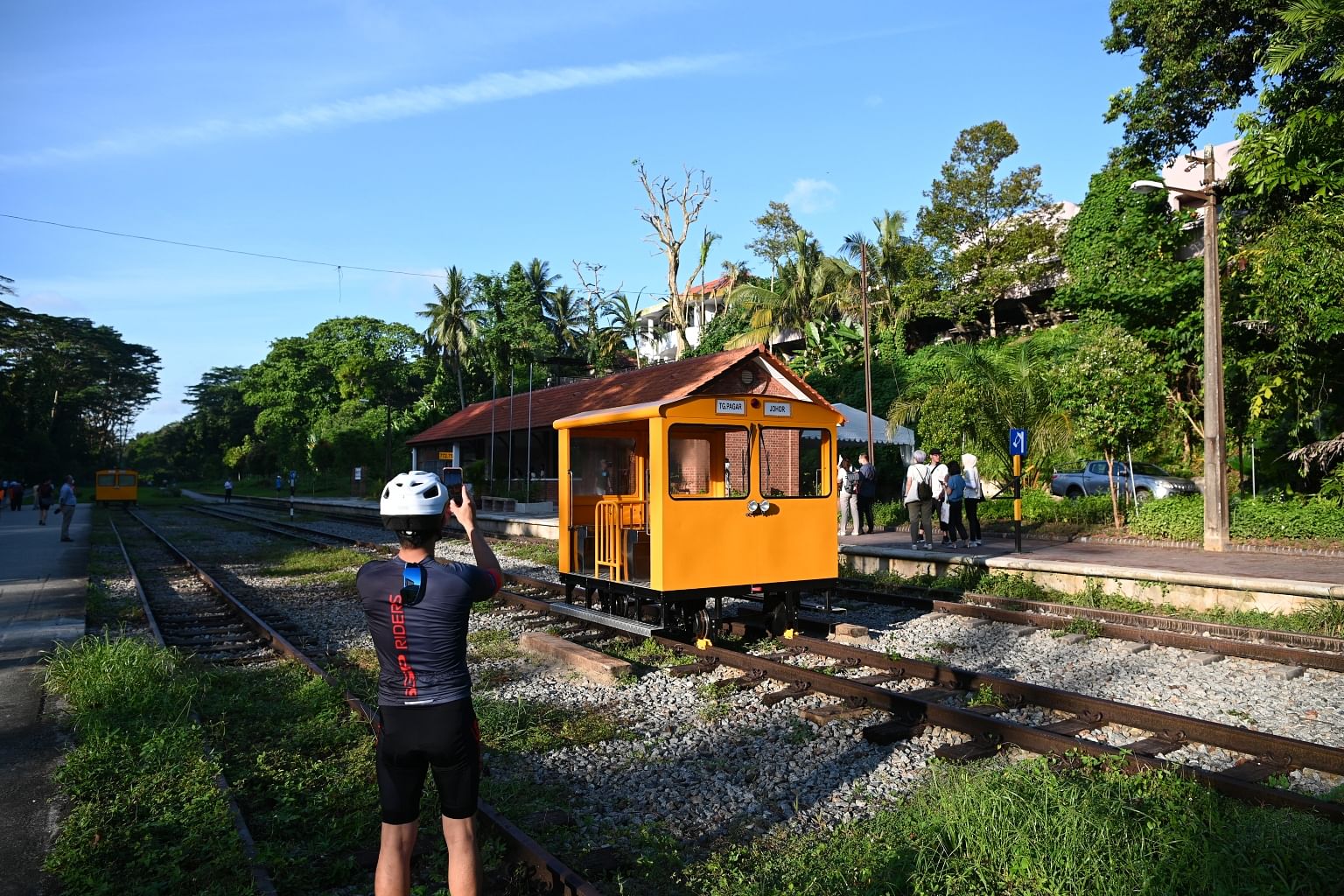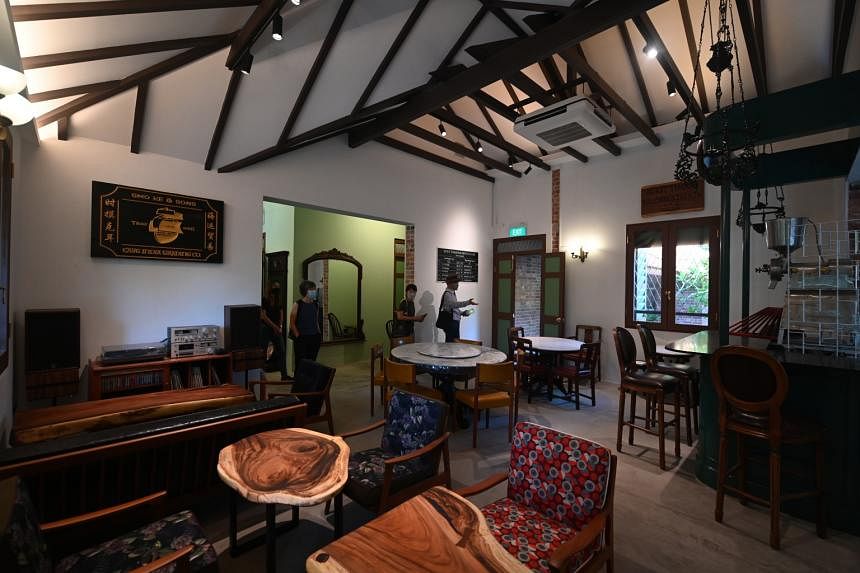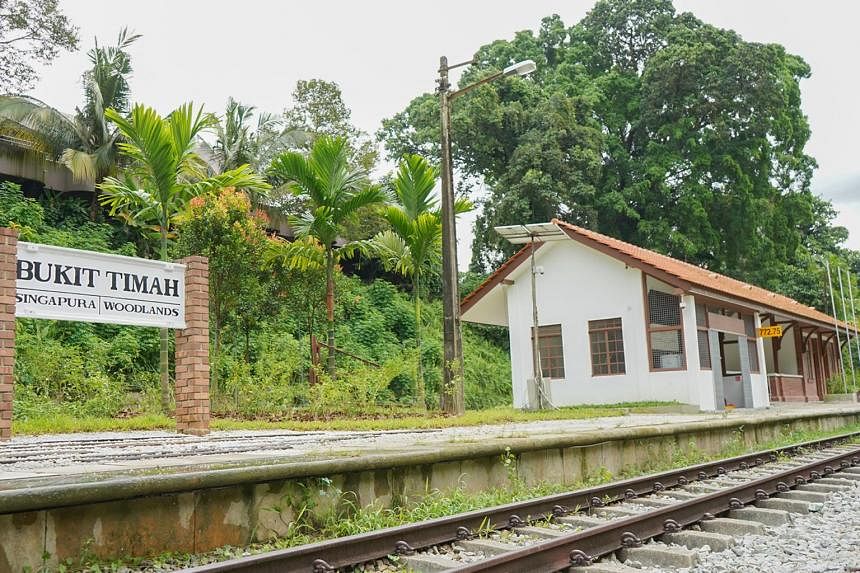SINGAPORE - After two years of restoration works, the Bukit Timah Railway Station and Railway Staff Quarters, located at about the midpoint of the 24km Rail Corridor, have reopened to the public.
Visitors can now learn about the former railway line's history in the heritage gallery housed in the old railway station and relax at a cafe inside the former staff quarters, as well as enjoy new amenities, gardens and lawns.
Officiating at the opening of the new 4.3ha Bukit Timah Railway Station community node on Friday (July 1), National Development Minister Desmond Lee said the public had been engaged on how to preserve the station's heritage.
He said restoration plans had taken in an in-depth study of the site by Singapore University of Technology and Design students. Accessibility for people on wheelchairs, seniors, and families with young children was also taken into consideration.
The node is located right by the Bukit Timah truss bridge and is most easily accessed from the King Albert Park MRT station.
"We have now conserved its two buildings and ensured that they are safe and accessible for everyone while retaining their nostalgic charm," said Mr Lee.
For instance, in the railway station's signal room, six original levers used by station masters to control track switching and signalling for passing trains were kept.
New gardens to enhance the station's character were also added, such as the Kampung Garden, which contains species including the hibiscus, peacock flower and jasmine found in 1960s kampungs here.
Night lighting in the area will be kept to a minimum to avoid disturbing nocturnal animals, said Mr Lee.
Friday marks exactly 11 years since the 24km stretch of land occupied by the Keretapi Tanah Melayu railway line was returned to Singapore. Bukit Timah was one of several stations on the line, with the southern terminus being Tanjong Pagar Railway Station.
The Urban Redevelopment Authority (URA) and the National Parks Board (NParks) said visitors inside the Bukit Timah station building will get to see a ticketing booth and a replica of a signals diagram in the station's signal room.

Conservator Yeo Kang Shua, who was the restoration project’s heritage consultant, said that while it was technically straightforward, the challenges lay in the relatively small scale of the heritage buildings.
Workers had to be extremely cautious, he said, as any mistake they made would have damaged a significant percentage of the buildings given their size.
For instance, special care was given to 20 half-domed ventilation tiles that were retained as part of the buildings’ roofs and are no longer in production.
In front of the building, which was built in 1932, more restored features can be found, such as station signs and token poles. There are also replicas of railway station wagons that were used as railway maintenance vehicles.

URA executive architect John Wan said the agency wanted to make the site relevant and used by the public, hence the wagons were introduced as a play feature and photo opportunity.
At the former staff quarters, located opposite the old rail tracks from the station building, a cafe has opened at one of the two houses, offering local and fusion fare. Next door, a "heritage wing" has been created, retaining the layout, features and details of the house to showcase its former use as a residential building.
Here, the toilet block has been spruced up and provides a showcase for how sanitation systems have evolved over past decades through displays of night-soil collection, a septic tank for on-site waste treatment and a modern sanitary system of underground lines with inspection chambers and a grease trap.
Mr Marcus Wang, who owns 1932 Story, the new cafe in the staff quarters, said he was enticed to place a bid for the space having previously lived close to the railway line in a kampung near the former Bukit Timah Fire Station.
“The request by NParks was not for a modern cafe, but one that reflected the olden times and as a furniture-maker, I thought I could contribute my passion,” said Mr Wang, who decorated the cafe space with some antiques of his own such as an old television.

Last month, the Rail Corridor was identified as one of five identity corridors by URA in its heritage and identity structure plan.
"This means that we will plan the entire 24km length of the Rail Corridor with an intent to preserve this unique character," said Mr Lee on Friday.
For instance, he said urban design strategies will guide developments along the corridor.
"This ensures that visitors can enjoy an uninterrupted view of greenery throughout the corridor, without tall buildings looming over them where we can," he added.

Mr Takayuki Kawada, 41, who previously lived in Singapore and had returned on a business trip, said he was paying a visit to the railway station after finding out online that it had been restored.
“It is important to keep historical architecture to remember past stories and retain the culture of the area,” said Mr Kawada, who works in the energy sector.
He added that during previous visits to the area, he could not enter the station. He was thrilled to find it open this time.
Mr Lee said the authorities are currently working with student volunteers from the National University of Singapore's environmental studies programme to create an interactive online map of the central segment of the Rail Corridor, which will be launched in September.
The authorities will continue to work with the community "to realise the Rail Corridor's full potential", said Mr Lee, who also announced forthcoming developments for the corridor.
Heritage blogger and author Jerome Lim, who has documented the railway station, said he was glad of how the restoration work had turned out.
“It was tastefully done, retaining the area’s rustic flavour and charm that takes you away from Singapore,” he said.
Mr Leong Kwok Peng, a long-time advocate for the Rail Corridor to be kept as a continuous nature trail instead of being cut up for development, said he appreciated the effort made to restore the area, but would have liked to see more of the railway track restored.
“We should bring back the rail to the rail corridor,” he said. “It would be nice to restore the track from the station up to the Bukit Timah truss bridge to retain the feel and enhance the photogenic value of the area. The stretch of retained tracks at the station is too short.”
Noting that trains that used to traverse the line carried natural resources such as timber and rattan, he said: “We have taken so much, now it’s time we give back through the trail’s retention for nature.”




